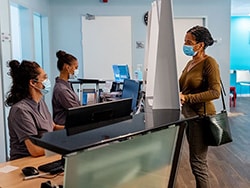Each day, thousands of patients with varied medical needs ranging from urgent care to nonemergent, elective medical services must wait to see a doctor. For new patients joining an ever-growing appointment list, the experience can be more daunting.
Add to that an aging physician workforce, rising burnout, and shortages across the nation, and the result can be bad for both patients and their doctors.

According to a recent report by staffing firm AMN Healthcare and its physician consulting subdivision Merritt Hawkins, the average time a new patient needs to schedule a physician appointment across the United States has increased significantly, by 8% since 2017 and 24% since 2004.
The report, “2022 Survey of Physician Appointment Wait Times and Medicare and Medicaid Acceptance Rates,” suggests that it now takes an average of 26 days to schedule a new patient physician appointment in the 15 cities that constitute the most extensive healthcare markets in the States.
This includes Atlanta, Boston, Dallas, Denver, Los Angeles, Miami, New York, Philadelphia, San Diego, and Washington, DC.
“Growing demands from an aging population coupled with a static and diminishing supply of physicians, physician burnout, retirement, and turnover were major challenges escalating patient wait times prior to COVID,” Tom Florence, president of Merritt Hawkins, told Medscape Medical News. “The pandemic added accelerant to these problems, and now retaining physicians has become an even greater challenge.”
The researchers estimated data from 1034 physician offices across five medical specialties — cardiology, dermatology, obstetrics-gynecology, family medicine, and orthopedic surgery — during a 10-week period between March and mid-May 2022.
The survey sought to simulate a patient experience when trying to schedule a physician appointment for common nonemergent medical conditions, such as a physical exam, a heart check-up, a skin exam, a knee injury, or a gynecologic exam.
“This is the only survey that tracks physician availability through the ‘secret shopper’ technique,” said Florence. “It offers practical data on what patients might experience if they had to find a physician rather than estimate the theoretical number of physicians a community may need.”
The survey yielded the following additional key findings:
-
The average appointment wait time for an ob/gyn increased by 19%, from 26.4 days in 2017 to 31.4 days. Among the cities, Philadelphia has the longest ob/gyn appointment wait time, at 59 days, whereas New York City has the shortest, at 19 days.
-
For a cardiology appointment, the average wait time rose by 26%, from 21.1 days in 2017 to 26.6 days. Cardiology appointment wait times are the longest in Portland, Oregon, at 49 days, and the shortest in Dallas, at 13 days.
-
Dermatology appointment wait times had a 7% increase since 2017, from 32.3 days to 34.5 days. The average wait time to see a dermatologist ranges from a high of 72 days in Minneapolis to 9 days in Philadelphia.
-
The average wait time to see an orthopedic surgeon is up by 48%, from 11.4 days in 2017 to 16.9 days. Average orthopedic surgery wait times are the longest in San Diego, at 55 days, and the shortest in Washington, DC, at 5 days.
-
Relative to 2017 reports, family medicine is the only specialty with a lower average appointment wait time. As a result of the adoption of telemedicine and urgent care centers, the average wait time for a family medicine appointment decreased by 30%, from 29.3 days in 2017 to 20.6 days. At 44 days, Portland, Oregon, has the longest wait time to see a family physician, whereas Washington, DC, has the shortest, at 8 days.
-
Across all five specialties within the 15 major metro markets, Portland, Oregon, has the highest average new patient appointment wait times, at 45.6 days, whereas New York has the shortest, at 17.4 days.
To improve patient wait times, Florence recommends restructuring physician work patterns to minimize the time that physicians spend entering data, documenting their work, seeking preauthorization, or dealing with payers.
“Other options include off-loading work to other HCPs, such as NPs and PAs, when appropriate and extending the physician workforce through telehealth,” he said. “We would need fewer physicians if we could get healthier as a nation by implementing preventive medicine and promoting better overall health through diet, exercise, and general population health management.”
Oladimeji Ewumi is a freelance writer based in Lagos, Nigeria, specializing in healthcare, life sciences, and medical artificial intelligence.
For more news, follow Medscape on Facebook, Twitter, Instagram, and YouTube
Source: Read Full Article


